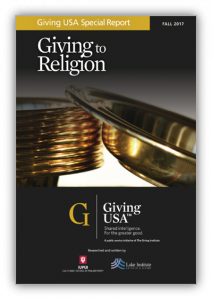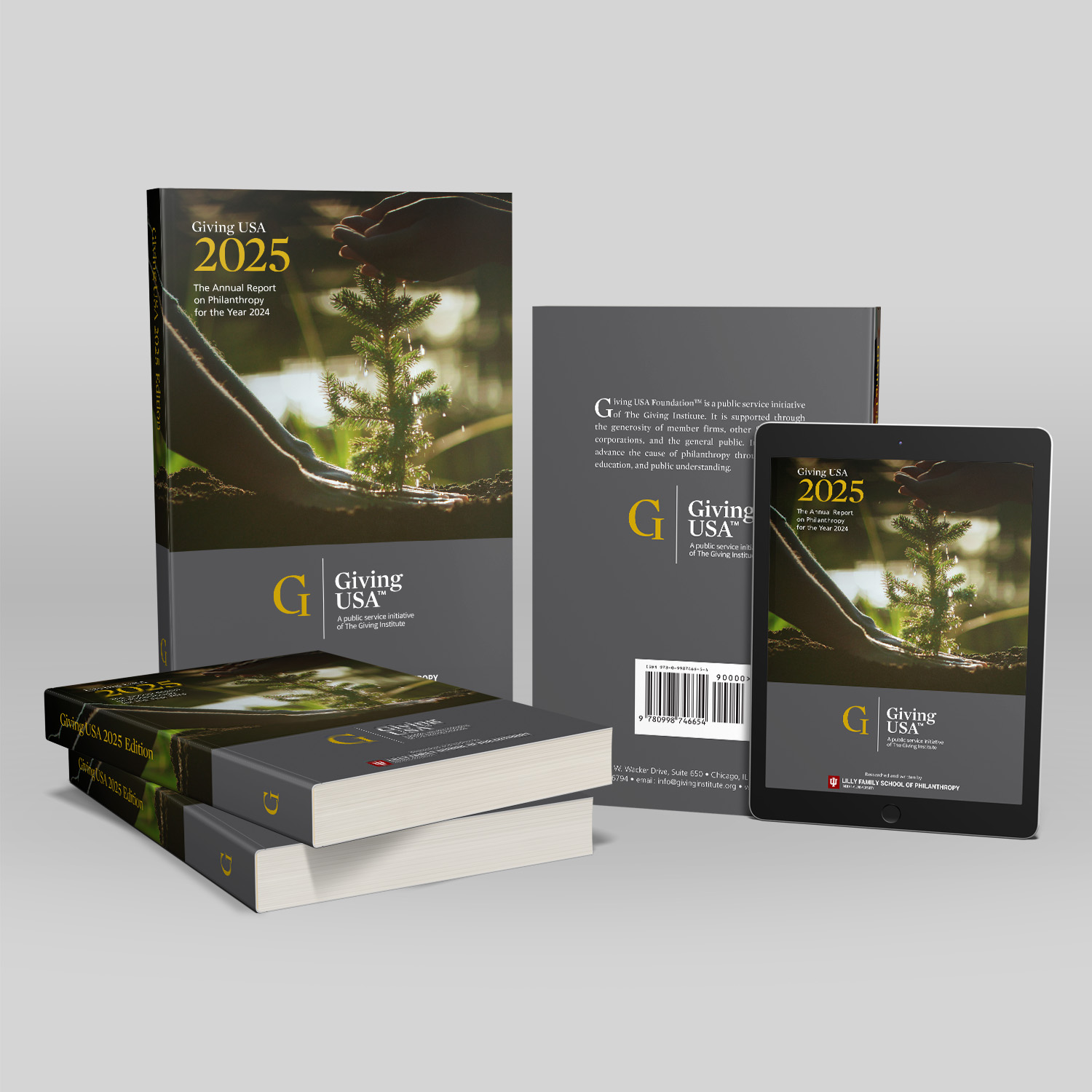 Religiously affiliated people more likely to donate, whether to place of worship or other charitable organizations, new report finds.
Religiously affiliated people more likely to donate, whether to place of worship or other charitable organizations, new report finds.
Special Report on Giving to Religion from Giving USA Foundation™ and the Lilly Family School of Philanthropy explores religious giving in an era of declining affiliation and attendance.
At a time when affiliation with a religion and attendance at religious services are both decreasing in the United States, a new report sheds light on how those trends are affecting charitable giving to religious congregations and to other types of charitable institutions.
The Giving USA Special Report on Giving to Religion released on October 24, 2017, was researched and written by the Lake Institute on Faith & Giving at the Indiana University Lilly Family School of Philanthropy with support from the Giving USA Foundation™.
The report is based on newly released data from the Lilly Family School of Philanthropy’s Philanthropy Panel Study (PPS), which tracks more than 9,000 individuals’ and families’ giving and dynamic factors that influence those practices (e.g., employment, health and marital status) throughout their lives. PPS is the leading and most accurate resource for measuring U.S. household giving.
“By combining the PPS’s extensive, reliable data and the expertise of our research team, the report gives us the ability to discover how patterns of giving to religion are evolving over time, and how faith and religion influence donors’ giving to non-religious causes as well,” said David King, Ph.D., the Karen Lake Buttrey Director of Lake Institute on Faith & Giving at the school. “This report also raises the importance of the need for research in new areas such as how congregations teach, manage, and create a culture around charitable giving in an era of declining religious affiliation.”
A household’s affiliation with a faith tradition and its frequency of attendance at religious services play important roles in their charitable giving to religious institutions and other types of charitable organizations. The report presents a number of findings about the current state of religious giving, addresses the unique challenges of measuring giving to religious congregations, summarizes previous research and provides conclusions about the state of the field.
Among the report’s findings:
- People who are religiously affiliated are more likely to make a charitable donation of any kind, whether to a religious congregation or to another type of charitable organization. Sixty-two percent of religious households give to charity of any kind, compared with 46 percent of households with no religious affiliation.
- Although the percentage of people who give to religious congregations is declining, those who give to religion are giving at steady rates. Contrary to popular belief, younger generations do give to religion, and those who give are doing so at a similar rate as earlier generations did at the same point in their lives.
- Frequent attendance at religious services is linked to both the likelihood of giving to religion and to making larger gifts to religion. People who attend religious services on a monthly basis are 11 times more likely to give to religious congregations, and they give an average of $1,737 more to religion per year than people who attend less than once a month.
- Donors to religious causes between the ages of 40 and 64 give the largest amounts, giving an average of $2,505 per year. Donors to religious causes who are younger than 40 years old give an average $1,892 and donors who are 65 or older give an average of $2,338.
- Giving to religion increases as donors’ income increases, but donations decrease as a share of donors’ overall income. Households with an annual income greater than $100,000 give an average of $1,600 more to religion per year than households with an income of less than $50,000.
- Religiously affiliated households give as much or more to other types of charities as non-religiously affiliated households do.
“One of the more important findings of the study is the fact that younger generations do give to religion, and do so at a rate that is similar to earlier generations,” said Rick Dunham, a Board member of Giving USA Foundation, and President and CEO of Dunham and Company, a fundraising company specializing in faith-based nonprofits. “It is reasonable to expect that as younger generations mature, they will be similarly engaged in charitable giving as older generations are.”
Religious congregations receive the largest share of American charitable giving. They received 32 percent of all charitable donations in 2016, according to the most recent estimates from Giving USA 2017. Giving to religion totaled $122.94 billion—more than double the $59.77 billion given to education, the next largest subsector.
The steady rate of giving among donors to religious congregations, and other findings in the report, indicate that these institutions are effectively engaging their congregations. These interactions at the congregational level are crucial and need to be better understood through additional research.
Giving to religious congregations is often challenging to calculate, in part because there is no single source of data where scholars can gain information about the subsector overall. Because faith-based institutions are not required to file IRS Forms 990, studies must rely instead on data compiled by denominational associations, a process that can miss independent congregations and congregations of different faith backgrounds. Giving USA: The Annual Report on Philanthropy is the only yearly report that estimates giving to religion on a national scale across faith traditions. The Special Report on Giving to Religion offers a snapshot of the characteristics and practices of individuals and households who give to religion.
“Giving USA has long provided the most rigorous estimations for giving to religion, and this new report using PPS data gives us a more in-depth portrait of individual giving behaviors, deepening our understanding of this vital area of the philanthropic sector,” said Una Osili, Ph.D., associate dean for research and international programs at the Indiana University Lilly Family School of Philanthropy.
NOVEMBER 8 GURIN FORUM, “IMPACT OF RELIGION ON PHILANTHROPY”
Moderated by Stacy Palmer, Editor of The Chronicle of Philanthropy, expert panelists will discuss the findings from the Giving USA Special Report on Giving to Religion during the Giving USA Foundation and Giving Institute November 8 Gurin Forum, “The Impact of Religion on Philanthropy.” Panelists include Wendy C. Abrams, Chair, National Women’s Philanthropy Board of the Jewish Federations of North America; Dan Conway, Senior Vice President of Collegium Holdings, Inc.; Rick Dunham, CEO of Dunham+Company
Una Osili, Professor of Economics and Associate Dean for Research and International Programs, Indiana University, Lilly Family School of Philanthropy; and Kashif Shaikh, Co-Founder and Executive Director of the Pillars Fund. Broadcast live from Chicago from 11:00am-12:30pm CDT, the live webcast is free for all to attend. Learn more and register for this complimentary webcast here.
NOTE TO EDITORS
For the purposes of this report, giving to religion follows the same definition used in the Giving USA annual report, which includes giving to congregations, religious media, mission organizations, and denominational bodies. (This definition is based on the National Taxonomy of Exempt Entities (NTEE) system.) It does not include donations inspired by religious belief, nor does it count donations to faith-based human services organizations, health care institutions, or private educational institutions.
About Giving USA Foundation
Advancing the research, education and public understanding of philanthropy is the mission of Giving USA Foundation, founded in 1985 by The Giving Institute. Headquartered in Chicago, the Foundation publishes data and trends about charitable giving through its seminal publication, Giving USA, and quarterly reports on topics related to philanthropy. Published since 1956, Giving USA is the longest running, most comprehensive report on philanthropy in America. Giving USA 2017: The Annual Report on Philanthropy for the Year 2016 is available now at www.GivingUSA.org. Read more about Giving USA Foundation’s history, as well as the history of Giving USA and philanthropy in the U.S. in the Giving USA 2015 Spotlight: Celebrating Service to Philanthropy (available as a free download on www.GivingUSA.org).
About the Indiana University Lilly Family School of Philanthropy
The Lilly Family School of Philanthropy at IUPUI is dedicated to improving philanthropy to improve the world by training and empowering students and professionals to be innovators and leaders who create positive and lasting change. The school offers a comprehensive approach to philanthropy through its academic, research and international programs and through The Fund Raising School, the Lake Institute on Faith & Giving and the Women’s Philanthropy Institute. Follow us on Twitter @IUPhilanthropy and “Like” us on Facebook.
The Giving USA Special Report on Giving to Religion is available for $24.95 in digital PDF format or as a paperback book (with digital download) for $29.95.


